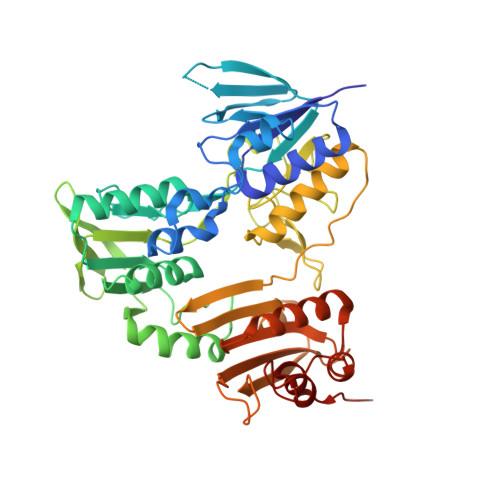A broader active site inPyrococcus horikoshiiCoA disulfide reductase accommodates larger substrates and reveals evidence of subunit asymmetry.
Sea, K., Lee, J., To, D., Chen, B., Sazinsky, M.H., Crane, E.J.(2018) FEBS Open Bio 8: 1083-1092
- PubMed: 29988575
- DOI: https://doi.org/10.1002/2211-5463.12439
- Primary Citation of Related Structures:
5L1N - PubMed Abstract:
Within the family of pyridine nucleotide disulfide oxidoreductase (PNDOR), enzymes are a group of single-cysteine containing FAD-dependent reductases that utilize a tightly bound coenzyme A to assist in the NAD(P)H-dependent reduction of di-, per-, and polysulfide substrates in bacteria and archaea. For many of these homodimeric enzymes, it has proved difficult to determine the substrate specificity and metabolic function based on sequence and genome analysis alone. Coenzyme A-disulfide reductase (CoADR) isolated from Pyrococcus horikoshii ( ph CoADR) reduces Co-A per- and polysulfides, but, unlike other highly homologous members of this group, is a poor CoA disulfide reductase. The ph CoADR structure has a narrower access channel for CoA substrates, which suggested that this restriction might be responsible for the enzyme's poor activity toward the bulky CoA disulfide substrate. To test this hypothesis, the substrate channel was widened by making four mutations along the channel wall (Y65A, Y66A, P67G, and H367G). The structure of the quadruple mutant shows a widened substrate channel, which is supported by a fourfold increase in k cat for the NAD(P)H-dependent reduction of CoA disulfide and enhanced activity toward the substrate at lower temperatures. Anaerobic titrations of the enzyme with NADH revealed a half-site reactivity not observed with the wild-type enzyme in which one subunit of the enzyme could be fully reduced to an EH 4 state, while the other remained in an EH 2 or EH 2 ·NADH state. These results suggest that for these closely related enzymes, substrate channel morphology is an important determinant of substrate specificity, and homology modeling will be the preferred technique for predicting function among PNDORs.
- Department of Chemistry Pomona College Claremont CA USA.
Organizational Affiliation:


















